| Lot |
Photo |
Description |
Realized |
Lot 759 |
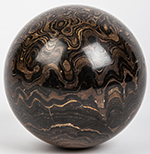 |
5 Inch Stromatolite Sphere. Stromatolites are fossils of laminated rock formed from the layer-by-layer buildup from microbial mats of cyanobacteria over thousands of years. Stromatolites formed the very first macro fossils found in the fossil record going back several billion years. This beautiful 5" sphere from Bolivia's eastern Andes, weighs over 6 pounds and is roughly 2.3 billion years old. The fossilized dark brown rock was cut and polished and contains many tan and lighter brown fossilized cyanobacteria colonies, resembling concentric oval rings on top and wavy concentric layers all along the side of the sphere; making the overall appearance to be like that of a strange planet. A small display ring is included to help showcase this spectacular piece.
Estimated Value $400 - 500.
View details and enlarged photos
| Realized
$552 |
Lot 760 |
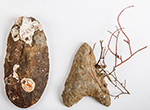 |
A Coral-Encrusted Prehistoric Shark (Megladoon) Tooth. Together with a Shell-Encrusted Florida Indian Pre-Columbian Axe, 6.25 inches. This amazing prehistoric shark's tooth, 4.5 inches, was found in the ocean off the Florida coast, a stark reminder of the enormous creature's size in prehistoric times. Coral has embedded itself in the tooth, aside from that, it is in excellent condition. Included in this lot is a shell-encrusted Pre-Columbian axe, encrusted from its time on the seabed.
Both items contained in a specimen display box.
Estimated Value $300 - 400.
View details and enlarged photo
| Unsold |
Lot 761 |
 |
Ammonites And Belemnites. The 180 million year old Posidonia Shale of Holzmaden, Germany is famous for the exceptional preservation of its fossil sea creatures. The black slate is a perfect matrix for the golden brown fossils that are occasionally encountered. This large 14 x 12 inch black slate matrix contains six beautiful golden brown ammonites, Dactylioceras commune ranging in size from 1 to 3 inches in diameter. There are also two three inch long Belemnite guards that are brown in color with one having a bright gold color pyritized end. Belemnites were squid-like animals with 10 equal tentacles extending out from their head and a shell like guard at the end of their tale to balance their head when swimming. The guard was the only hard part to their body and therefore the only part found as a fossil. There is even a 1.5 inch pygidium of a trilobite on the plate. The museum quality plate has been evenly cut and has a hook imbedded in the back for hanging. This is a rare opportunity to acquire a beautiful fossil from a classic fossil site.
Add $30 for domestic shipping.
Estimated Value $700 - 1,000.
View details and enlarged photo
| Unsold |
Lot 762 |
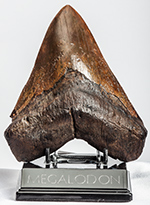 |
Carcharodon megalodon Shark's Tooth. Even though Carcharodon megalodon was the largest shark that ever lived, growing to more than 50 feet in length, most of the teeth found are only 3-4 inches in length. Teeth over 5 inches in length are in great demand. This large 5.9 inches long 15 million year old Carcharodon tooth was found in the muddy river waters of South Carolina. Estimating the length of a shark at about 10 feet in length to every one inch of tooth, this behemoth would be almost 60 feet long. This huge tooth has light brown enamel and a dark brown root. There is some restoration on the bottom two inches of the point of the blade with excellent matching color. The top half of the blade has very good serrations as well. This is an opportunity to purchase a really huge shark's tooth without paying well over $1500. Includes a 7 x 5" custom wooden stand for display.
Add $15 for domestic shipping.
Estimated Value $500 - 750.
View details and enlarged photo
| Realized
$408 |
Lot 763 |
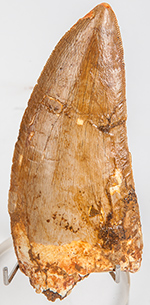 |
Carcharodontosaurus Dinosaur Tooth. Large 3.4 inch long (around the curve) complete dinosaur tooth of Carcharodontosaurus saharicus, the T-Rex of Africa. Even though Carcharodontosaurus was even larger than a T-Rex, most of the teeth found are only 1.5 to 2.5 inches long. This complete light brown shed tooth has very good enamel with about 40% of the steak knife-like serrations present on both edges of the tooth. This tooth was found in two pieces with 1.25 inches of the tip being reattached to the rest of the tooth. This large impressive tooth was found in the Sahara desert of Morocco and Carcharodontosaurus was older than a T-Rex at 70-80 million years old and is an excellent value for a huge carnivorous dinosaur tooth as a T-Rex tooth this size would cost more than $3,000. Housed in a 6X5 inch Riker mount.
Add $15 for domestic shipping.
Estimated Value $275 - 375.
View details and enlarged photo
| Realized
$456 |
Lot 764 |
 |
Dinosaur Tail Vertebrae. Edmontosaurus was North American Duck Billed (hadrosaur) dinosaur that was one of the largest of the Duck Billed dinosaurs and a favorite food item for T-rex. This huge tail vertebrae 13 x 8.5 inches weighing 6.5 pounds was from an adult Edmontosaurus that was probably over 40 feet long. The large tail vertebrae has its central hole that contained nerves and blood as well as the side processes where its tail muscles attached. This late cretaceous 66-67 million year old dinosaur fossil was found on private land in the Hell Creek Formation of West Central South Dakota.
Add $30 for domestic shipping.
Estimated Value $500 - 750.
View details and enlarged photo
| Unsold |
Lot 765 |
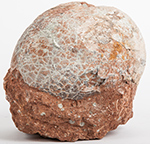 |
Duckbill Dinosaur Egg. This large complete unhatched Duckbill dinosaur egg is 70-80 million years old from Central Asia,measures: 6 x 5.5 inches and is unprepped with 90 percent of its original shell intact. The egg shell is mostly a brown color with some of the matrix still adhering to the shell. It is fully inflated and not crushed without any restoration, its just as it came from the ground. The egg has been completely removed from the underlying matrix which is unusual and contains some original shell on both the top and bottom. It still rests on a block of reddish-brown matrix. We do not know to what Duckbill species this egg belongs as no embryonic bones have ever been found in the Duckbill dinosaur eggs, but we do know that it is from a hadrosaur better know as a Duckbill dinosaur because of its shape.
Add $30 for domestic shipping.
Estimated Value $375 - 550.
View details and enlarged photo
| Realized
$300 |
Lot 766 |
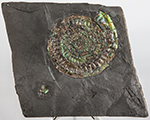 |
Green Iridescent Ammonite. Somerset, England is famous for its beautiful iridescent ammonites. The 195 million year old fossils of the Blue Lias Strata have the original ammonite shell being changed over millions of years with minerals filtering down through the ground and being compressed by the weight of the overlying rock thus yielding a lustrous pearl-like substance that is considered a gemstone named Ammolite. This 4.25 inch diameter Psiloceras ammonite has been compressed on a 7 x 6.5 inch black slate matrix with spectacular splashes of beautiful green color mixed with a medium brown.
Add $15 for domestic shipping.
Estimated Value $375 - 500.
View details and enlarged photo
| Realized
$420 |
Lot 767 |
 |
Huge Amber Slab With Insects. This huge 6.75 x 2.5 inch museum quality clear honey(amber) colored amber slab from Colombia contains several different insects including more than a dozen ants and a complete golden spider that looks like it was dipped in gold. as well as a couple of small twigs with unusual small bright red spheres that could be algae or some type of small berry. This large and hefty 202 gram slab has an esthetic shape like a huge arrow head. The absolute age of young Colombian amber or copal cannot be determined as amber itself cannot be tested and dated, but from the quintessential amber color and hardness of these slabs and nuggets, experts suggest their age to be at least 1-5 million years old and probably much older. By using a magnifying glass the detail is amazing. Comes with a 4 inch illusion stand for display.
Add $15 for domestic shipping.
Estimated Value $600 - 900.
View details and enlarged photo
| Realized
$394 |
Lot 768 |
 |
Huge Spinosaurus Dinosaur Tooth. Made famous in "Jurassic Park III" as the dinosaur that killed a T-Rex, the enormous 80 million year old theropod dinosaur Spinosaurus with a huge sail on its back remains an enigmatic dinosaur as no skeleton even remotely complete has been found and the only partial skeleton was destroyed in World War II. Spinosaurus is mostly known from its teeth which are fairly common but usually less than two inches long, broken, and ugly. This huge 6.75 inch tooth is the exception having lovely brown colored enamel and a large section of cream colored root. This tooth was found in two pieces with the top two inches of the tip being reattached with some minimal restoration. The real tip may have come from another specimen of Spinosaurus but there is a good color match and still this is one of the largest Spinosaurus or any therosaur teeth known. The enamel of the tooth with tip is 4.5 inches long with a 2.25 inch root section. This rare dinosaur teeth was found in the Kem Kem Valley near Taouz, Morocco (near the border with Algeria). This huge tooth comes with a 2 inch illusion stand for display.
Add $15 for domestic shipping.
Estimated Value $600 - 800.
View details and enlarged photo
| Realized
$384 |
Lot 769 |
 |
Jurassic Pine Cone. This exquisite large 2.6 inch long 210 million year old pine comes from Patagonia, Argentina and has been cut in half and polished to reveal the inner beauty of the silicified seed kernels fossilized intact within. The seeds and core range in several hues from beige to orange. This rare preservation came from some giant over 100 feet tall) Araucaria mirabilis pine trees that were buried under volcanic ash over 160 million years ago. There is great demand for these beautiful pine cones as the site has been closed to collectors.
Add $15 for domestic shipping.
Estimated Value $300 - 450.
View details and enlarged photo
| Realized
$192 |
Lot 770 |
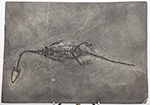 |
Keichousaurus Skeleton. Keichousaurus hui was the 240 million year old ancestor from Guizhou Province, China of the famous long necked sea reptiles Plesiosaurs which were made famous as being the best choice for the mysterious Loch Ness monster. Keichousaurus also lived in the ocean and had a long, flexible neck, tiny sharp teeth, webbed feet and a tail as long as its neck. This 4.5 inch long excellent dark brown 3-D fossil has an excellent skull with some small teeth visible, well defined bones and is well positioned on a 5 x 3.5 inch medium grey slate matrix. All of the bones present are of top quality with all four legs present with even the tiny digits of the feet.
This museum quality fossil is a real Chinese dragon and comes preserved in a 8 x 6 inch Riker Mount.
Add $20 for domestic shipping.
Estimated Value $600 - 800.
View details and enlarged photo
| Realized
$456 |
Lot 771 |
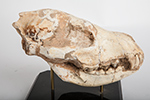 |
Mammal Hyena Ictitherium Skull. This excellent complete 26 million year old fearsome mammal skull belonged to one of the earliest types of Hyenas that looked vastly different from the Hyenas that exist today. Hyena ictitherium lived in eastern Asia and looked something like a Civet with a long 4 foot body and short powerful legs. Their massive skulls with sharp over one inch long canines clearly show that they were carnivorous and likely hunted in packs. This museum quality skull was prepared out of the original matrix with some of the matrix still inside of the skull. The skull measures 8.5 x 5 inches and is virtually complete with just some cracks in skull but with all of the teeth present although some of the teeth have been placed back into position on the skull. This rare and impressive skull has been mounted on a 6 x 6 inch custom black Lucite stand making for a very impressive display.
Add $30 for domestic shipping.
Estimated Value $1,600 - 2,200.
View details and enlarged photo
| Realized
$930 |
Lot 772 |
 |
Mammoth Tusk. Complete tusks from a wooly mammoth Mammuthis primigenius are rare. This fairly large 29 inch long 2.75 inch diameter tusk is mostly complete with an excellent tip and just missing a small section that went into the jaw. The ivory itself is very solid with just a section near the center of both sides that has some light cracking in the outer ivory layer. It has been lightly polished revealing chocolate brown, beige and black colored ivory with a solid cream colored ivory core. These colors result from the original white ivory being mineralized over thousands of years with minerals such as vivianite and iron phosphate. This excellent quality tusk was found in the Taymyr Peninsula of Siberia and is between 30,000 and 100,000 years old. Most recovered Mammoth ivory is just broken pieces unlike this over 2 foot long curved exceptional quality tusk. The only ivory that can be legally sold is fossil ivory.
Add $50 for domestic shipping.
Estimated Value $900 - 1,400.
View details and enlarged photo
| Realized
$1,680 |
Lot 773 |
 |
Mammoth Tusk (30,000-100,000 years old). Complete tusks from the Woolly Mammoth Mammythis primigenius are rare. This complete 37" long, 2" diameter tusk is from a juvenile Mammoth and has been polished to reveal various shades of brown with patches of cream colored ivory. These colors resulted from the original white ivory being mineralized over thousands of years with minerals like vivianite and iron phosphate. This museum quality specimen was found in the Taymyr Peninsula of Siberia and is between 30,000 and 100,000 years old. Most recovered Mammoth ivory is found in broken pieces, unlike this exceptional full tusk.
Estimated Value $2,000 - 3,000.
View details and enlarged photo
| Realized
$3,600 |
Lot 774 |
 |
Megalodon Shark Tooth Collection. Carcharodon megalodon was the largest shark that ever lived growing to more than 50 feet in length and ate whales whose bones are found right alongside with the huge teeth of megalodon. This set of three teeth consists of an immense 6.1 inch 15 million year old Carcharodon tooth that was found in the muddy river waters of South Carolina. This greenish-gray tooth has an original root but about 50-60% of the edge of the blade has been repaired with an excellent color match. Estimating the length of a shark at about 10 feet in length to every one inch of tooth, this behemoth would be over 60 feet long. Also included is a 2.5 inch 2-6 million year old Great White Shark's tooth from Chile to compare what the size difference is between a 60 foot megalodon and a 25 foot Great White Shark tooth. To complete the collection is a 2.75 inch Whale's tooth that was found in the same area as the megalodon tooth in South Carolina. This interesting collection is housed in a 12 x 8 inch Riker Mount.
Add $25 for domestic shipping.
Estimated Value $500 - 750.
View details and enlarged photo
| Realized
$504 |
Lot 775 |
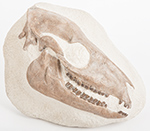 |
Mesohippus horse fossil. Mesohippus bairdi was a very small two foot tall 30 million year old horse. Horses were native to North America and Mesohippus was an early member of the perissodactyl horse which had three hooves on each foot. This brown original primitive horse skull is 8X4 inches on 9X4 inch limestone block and was found in the White River Badlands Formation of South Dakota. All of the fossil exposed from the matrix is original including all of the dark brown teeth. However, only the right half of the skull is exposed. More of the skull could still be contained in the matrix or more likely the other half of the skull is either missing or imcomplete. In any case this fossil horse skull makes and excellent display standing on its own crème colored stone matrix.
Add $20 for domestic shipping.
Estimated Value $550 - 900.
View details and enlarged photo
| Realized
$552 |
Lot 776 |
 |
Mesosaurus Marine Reptile. Mesosaurus was a very important 260 million year old marine reptile that was the first known reptile to return to the sea shortly after evolving from amphibians but even more importantly helped to prove the theory of continental drift as it is found only on the western part of South Africa and the eastern part of South America. This huge nearly complete 24 inch long fossil on a 20 x 10 inch limestone matrix is from the Irati Formation of Brazil. The attractive brown bone has excellent 3D detail of the vertebrae, rib bones, delicate neural spines and the crocodile-like skull that is preserved with several small sharp teeth visible in the clenched jaw. This considerably above average specimen has a complete body and tail with parts of one the front legs and parts of both back legs are preserved along with some disarticulated digits. This fossil Mesosaurus has both size and exceptional bone quality with the average Mesosaurus being only 12-16 inches long .
Add $35 for domestic shipping.
Estimated Value $1,000 - 1,500.
View details and enlarged photo
| Realized
$840 |
Lot 777 |
 |
Mosasaur Skull Plioplatecarpus ictericus. Mosasaurs were the T-Rex of the cretaceous seas. All mosasaurs skulls are rare because the skull bones are rather thin and light and easily break apart in the fossilization process. This magnificent 22 x 8 inch skull of Plioplatecarpus ictericus is 70 million years old and was found in Fall River County, South Dakota. It is complete accept for some crack repair and some tooth repair and is missing the back of the lower jaw which has been reconstructed and cast from another specimen. There are two rows of pterygoid teeth at the back of the mouth which were used to hold the prey animal while the mosasaur was swallowing it. Mosasaurs had double hinged jaws and probably shared a common ancestor with snakes. It is mounted on a custom black metal stand.
Plioplatecarpus ictericus was discovered and named in 1871 by Othniel Marsh during the Yale expedition along the banks of the Smoky Hill River. This is rare opportunity to acquire an unusual and interesting marine reptile skull.
Add $75 for domestic shipping.
Estimated Value $8,000 - 12,000.
View details and enlarged photo
| Unsold |
Lot 778 |
 |
Museum Quality Trilobite. Trilobites were one of the very first animals to possess eyes over 500 million years ago and became extinct 250 million years ago before there were dinosaurs. If you want to know what a trilobite looked like in life this is the specimen for you. This 375 million year old black trilobite Ondontochile was found near Erfoud, Morroco and has been meticulously prepared out of its original matrix in exquisite 3-D form. This delicate work takes dozens of hours of preparation but yields a magnificent trilobite. This museum quality specimen is 3.5 x 2.25 inches on a 3.5 x 1.5 inch original limestone matrix. The trilobite is complete and free standing with sharp 1.5 inch spines on the cephalon(head), many small lenses on one of the two compound eyes and even the small spine on the pygidium(tail) which is usually missing from preparing this trilobite. In addition, the hypostome (mouth) has been preserved on the underside of the head. The hypostome is rounded indicating that this type of trilobite was a filter feeder on the ocean bottom. The trilobite appears to be flying over the matrix and is as close as you can come to viewing what a living trilobite would have looked like.
Add $20 for domestic shipping.
Estimated Value $750 - 1,000.
View details and enlarged photo
| Realized
$456 |
Lot 779 |
 |
Needle Fish Fossil. Rhynchodercetis was an extinct Needle Fish that had a long "beak" like a swordfish. Its upper and lower jaws were extended forming a rostrum. This quite large 11 inch slender brown fish is 80 million years old from Kem Kem, Morocco. The fish is virtually complete with a large 2.5 inch long skull, small dorsal and ventral fins, vertebrae or impressions of vertebrae, missing only part of one of the tail fins. There are interesting small manganese dendrites extending from the slender jaw that give the appearance of being small teeth which they are not as Rhynchodercetis had no teeth. As usually found, the limestone matrix has been expertly repaired in two places but no parts of the fossil fish are missing.
Add $25 to domestic shipping.
Estimated Value $475 - 675.
View details and enlarged photo
| Realized
$288 |
Lot 780 |
 |
Oviraptor Dinosaur Egg. This original partially crushed unhatched Oviraptor egg is 70-80 million years old from the Gobi desert and is 6.75X5.5 inches and belongs to the largest of the two Oviraptor species called Citipati to distinguish it from the more common smaller species. Citipati Oviraptorids were made famous by the nest of eggs with the mother Citipati sitting on top of the eggs in a brooding position. This famous specimen is displayed in the New York Museum of Natural History and was discovered in 1995. It was revolutionary to discover a dinosaur sitting on top of its eggs like a bird and only later was it discovered that Oviraptors such as Citipati also had feathers like a bird. Citipati eggs are ratite in texture and have a very thin shell which is why they are rarely found complete. This unhatched egg has black and gray colored eggshell with the top side nearly completely covered by 90% original eggshell with some cracks and possessing its typical ratite pattern. The backside of the egg has about 65% black shell with much more cracking of the shell on one of the ends. This egg is very attractive and far above average for an Oviraptor egg.
Add $30 for domestic shipping.
Estimated Value $500 - 800.
View details and enlarged photo
| Realized
$336 |
Lot 781 |
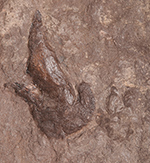 |
Pair Of Dinosaur Footprints. This pair of rare fossil dinosaur footprints are a dark brown in color on a 8.5 x 9 inch grayish brown shale slab. The footprints are from two different sized unknown bipedal theropod dinosaurs with the prints known as Grallator. The larger Grallator footprint is 5 x 3.25 inches and is deeply impressed in the fossilized mud. The center toe is especially deep and well detailed with a very distinct claw and an imprint of the padding on the bottom of the toe. The second smaller 2 x 1.5 inch foot print is less distinct and not as deeply impressed into the mud and positioned directly to the right of the larger print evoking perhaps a mother and baby dinosaur walking side by side. While the exact species of bipedal dinosaur that made the Grallator footprints is still unknown, it is similar in shape and size to the meat eating dinosaur Podokesaurus, a medium sized theropod, whose partial skeleton was found in the same area. These footprints are the more highly valued positive raised impressions which preserve the most detail of the dinosaur stepping in soft mud preserving some pad and claw details. All of the theropod dinosaur footprints preserve just three toes as theropods walked on their 2nd, 3rd and 4th toes which correspond to the three middle human toes.
Add $25 for domestic shipping.
Estimated Value $450 - 600.
View details and enlarged photo
| Unsold |
Lot 782 |
 |
Pair Of Oviraptor Eggs. This original pair of complete Oviraptor eggs is 70-80 million years old from Asia. These eggs were found in the Gobi desert and are 6 inches long x 2.5 inches wide and belong to a toothless birk-like dinosaur called Oviraptor. Oviraptors also had feathers like a bird. Oviraptor eggs are ratite in texture and have a very thin shell which is why they are rarely found complete. This average quality pair of eggs has good detail on their grayish brown shell and contain about 50% of their original shell with the usual cracks. The red limestone matrix has been removed from the bottom of the two eggs but is still visible between the eggs. Oviraptor eggs like all dinosaur eggs are becoming hard to locate and only become available when older existing collections are sold.
Add $30 for domestic shipping.
Estimated Value $750 - 1,200.
View details and enlarged photo
| Realized
$480 |
Lot 783 |
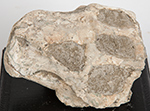 |
Psittacosaurus Dinosaur Skull. Psittacosaurus is a very important dinosaur that lived between 120-130 million years ago in Liaoning Province, Central Asia. Psittacosaurus is important as being the oldest ancestor of the famous horned dinosaurs such as Triceratops. Psittacosaurus did not have horns but did possess a horned beak and bony Jugals (back of the upper jaw) which are characteristic of only ceroptopsian (horned) dinosaurs. Psittacosaurus was a very small dinosaur being only 4-5 feet long as an adult. This 4 x 3.75 inch long skull is complete except for the end of one of the two jugals (jaw bone extension). The skull is not distorted and has one tooth and a partial second tooth although more teeth might still be buried under the matrix inside the jaw. The excellent preservation of this small delicate skull occurred because this dinosaur was instantly buried under volcanic ash over 120 million years ago in central Asia, a sort of dinosaurean Pompei It comes with a 5 x 4 inch black wooden stand for display.
Add $20 for domestic shipping.
Estimated Value $1,500 - 2,000.
View details and enlarged photo
| Unsold |
Lot 784 |
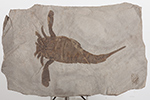 |
Sea Scorpion. Eurypterids also known as sea scorpions were fierce predators in the warm seas 425 million years ago. Some grew to over 6 feet long and easily hunted the slow moving armored fish of that era. Eurypterids were related to scorpions and were probably the first animal to leave the sea and crawl out on dry land. This complete highly detailed 4.25 inch sea scorpion, Eurypteurus remipes comes from the famous 425 million year old Fiddler's Green Quarry of Herkimer County, New York. This magnificent specimen is rare in that it is complete with all six of the walking legs as well as the two paddles being preserved with excellent detail along with an excellent head, body and telson (looks like the stinger in a scorpion but was not poisonous). The walking legs have amazing detail with the first two pairs of legs having feather-like ends that were used to sense prey. This Eurypterid is preserved in its underside (ventral position) that also enables some detail of its mouth as well. This museum quality Eurypterids is nicely centered on a 6.5 x 4.25 hard gray matrix.
Add $20 for domestic shipping.
Estimated Value $1,000 - 1,500.
View details and enlarged photo
| Unsold |
Lot 785 |
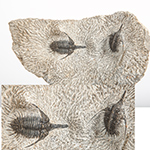 |
Shovel Nose Spiny Trilobite. One of the most spectacular spiny trilobites is the 375 million year old Psychopyge from Alnif, Morocco. Not only did it have short and long spines covering all of its body but it also had a long shovel-like appendage in front of its head that was probably used to dig in the ocean bottom to find prey and possible to hide from predators. This 7 x 4 inch light grey matrix contains two complete black Psychopyge trilobites. The larger specimen is 2.3 inches long and the small one 1.8 inches long. The larger specimen even has some of the lenses of its compaound eye visible. While both trilobites are virtually complete there has been some restoration done to some of the delicate spines which is normal for this fossil trilobite.
Add $20 for domestic shipping.
Estimated Value $450 - 650.
View details and enlarged photo
| Realized
$276 |
Lot 786 |
 |
Therizinosaur Dinosaur Egg. This rare dinosaur egg is very distinctive in being from the rare and poorly understood class of dinosaurs known as Therizinosaurs. Therizinosaurs were some of the strangest looking dinosaurs having some features of a plant eating dinosaur and some features of a theropod dinosaur. They had a small skull on a long neck with a large gut which resembled a plant eating dinosaur, but also were bipedal, had filamentous feathers, and extremely large hand claws up to three feet long in the largest species, like a theropod dinosaur. This egg is large for a Therizinosaur being 4 x 3 inches long and was deposited between 80-90 million years ago in the Xixia Basin of the Henan Province, China. This mottled medium brown egg is in excellent condition being unhatched and just slightly crushed. Even though the shell of Therizinosaur eggs is very thin, this egg contains 90 percent of its original shell on the top side and sits on a small section of the brownish-red matrix. Therizinosaur dinosaur eggs are much scarcer than Hadrosaur or Oviraptor eggs and are rarely offered for sale.
Add $20 for domestic shipping.
Estimated Value $350 - 500.
View details and enlarged photo
| Realized
$276 |
Lot 787 |
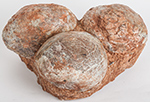 |
Three Egg Partial Dinosaur Nest. These three large complete inflated unhatched Duckbill dinosaur eggs are 70-80 million years old 6-6.5 inches in diameter and of museum quality with two of the eggs having 75- 85 percent of their original shell intact. The Third egg has about 50% original shell. These eggs are completely original with grayish brown fossilized eggshell nicely contrasting the original 12X9 inch red brown matrix.We do not know what Duckbill species these eggs belong to as no embryonic bones have every been found in the Duckbill dinosaur eggs, but being the largest Duckbill egg at a gigantic 6.5 inches in length(most eggs being 5-5.5 inches long) they might belong to the huge Duckbill dinosaur Shantungosaurus which reached more than 50 feet in length and has been found in the same area in the Henan Province of China. These museum quality dino eggs make an excellent display having much more original egg shell than normally found and resting on the original reddish brown limestone matrix. Dinosaur eggs are becoming hard to locate and rising sharply in value.
Add $45 for domestic shipping.
Estimated Value $1,700 - 2,200.
View details and enlarged photo
| Unsold |
Lot 788 |
 |
Trio Of Pyritized Russian Ammonites. Some of the most beautiful ammonites come from a small 160 Million year old section of the Volga River in the Ulianosk area of Russia. These Kosmoceras species ammonites are so highly value because of the beauty of their fossilization. When the ammonite is cut in half, the entire ammonite has been replaced with pyrite including many of the chambers that are filled with glittering crystals of pyrite also know as fools gold. This fossil consists of a three 1.50-1.75 inch diameter complete ammonites that have been cut in half revealing their open inner chambers filled with pyrite. Pyrite preservation in ammonites is very rare as most ammonites are preserved as fossils with calcite. Only in this small section of the Volga River were conditions just right for this beautiful pyrite preservation. In addition smaller complete ammonites have been placed in the center of each polished half for esthetic display. The ammonites have been placed back onto the hard black slate matrix with a cream colored interior similar to the matrix they were removed from making for a beautiful display.
Add $15 for domestic shipping.
Estimated Value $300 - 450.
View details and enlarged photo
| Realized
$270 |
Lot 789 |
 |
Tyrannosaurus Dinosaur Egg. Tyrannosaurus bataar dinosaur eggs from Central Asia are the largest and some of the rarest dinosaur eggs known. Tyrannosaurus bataar looked virtually the same as its more famous relative T-Rex but was slightly smaller in size and older in the fossil record at 70-80 million years old. Tyrannosaurus bataar may be the direct ancestor to T-Rex of which no eggs have ever been found. Tyrannosaur eggs are very rare because unlike herbivorous dinosaurs, tyrannosaurs were solitary animals that did not lay their eggs in colonies and only a single isolated nest is ever found. This rare gigantic egg is 16 x 5 inches compressed and completely removed from its stony matrix. There is about 80% original shell on the upper side and about 15% shell on the bottom. Some of the shell has been glued back on the egg and there is a repaired break on one of the ends. The egg is somewhat crushed which is almost always the case because of its immense size and the thinness of the shell. This size is just about the maximum possible because any egg cannot be any thicker or it would not allow oxygen in or waste gases to escape out and the embryo would die. These immense heavy 16 inch long eggs have definitely been identified as being from a tyrannosaur as embryos have been found in a couple of them with one even having a small skull with sharp theropod teeth. This egg is quite rare and desirable even with the restoration of some of the shell.
Add $45 for domestic shipping.
Estimated Value $800 - 1,250.
View details and enlarged photo
| Realized
$690 |